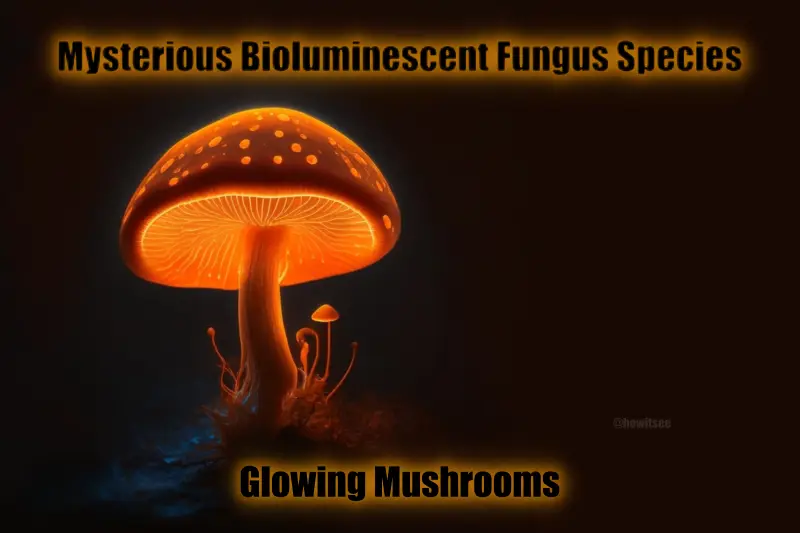Certain species have the amazing capacity to illuminate their bodies amid the enchanted realms of nature. When observed in low light conditions, these mushrooms emit a luminescence, creating an otherworldly ambiance in the surrounding environment.
The luciferin and luciferase enzymes in the mushroom’s mycelium undergo a chemical reaction that gives out illumination.
The world of bioluminescent mushrooms gives an enthralling display of nature’s splendor, ranging from the ethereal green light of the Bitter Oyster to the subdued blue radiance of Mycena lux-coeli.
In this article, we explore 15 Glowing Mushroom Species that possess the enchanting ability to emit light, illuminating the hidden wonders of the fungal kingdom.
15 Glowing Mushrooms
1. Bitter Oyster
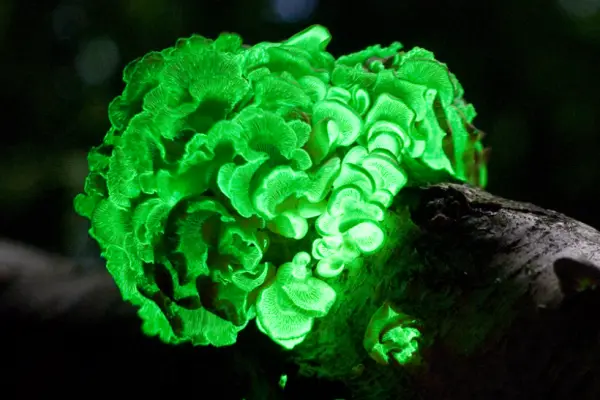
The Bitter Oyster (Panellus stipticus) is a mushroom species characterized by their small, fan-shaped caps. These thin and translucent caps exhibit various colors, ranging from white to pale yellow or even brownish hues.
They produce small spores that are part of their reproductive cycle in the gills, which are found under the caps.
These mushrooms generate a greenish luminescence when viewed in dim lighting. The bitter oyster mushroom often grows on dead hardwood branches, logs, or stumps.
Around the world, bitter oysters may be found in places including Australia, Asia, Europe, and North America. Oyster Mushrooms find temperate and subtropical climates favorable climatic conditions for their growth and development.
2. Green-spored Mycena
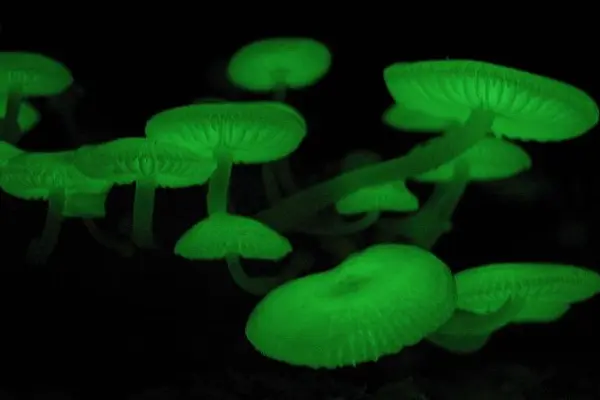
The next mushroom species on this list of Glowing Mushrooms, we have the Mycena chlorophos or the Green-spored Mycena.
In terms of appearance, the Green-spored Mycena typically has a translucent bell-shaped cap that ranges in color from whitish to pale yellow or even brownish tones.
Its stem is thin, fragile, and appears somewhat translucent. An aerobe, the Green-spored Mycena’s pileus, and gills give off a soft green glow.
The Green-spored Mycena is often found growing on decomposing wood or leaf litter in wooded areas. As a saprophytic organism, it contributes significantly to the decomposition process through nutrient recycling and the breakdown of organic debris.
3. Ghost Fungus (Omphalotus nidiformis)
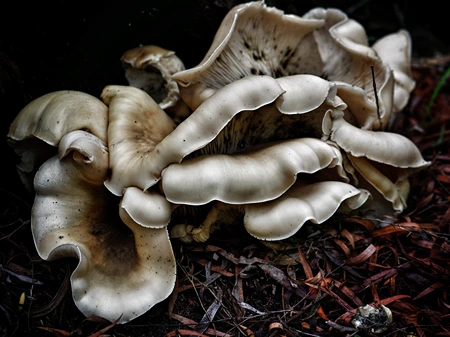
The Ghost Fungus has a gill-like appearance, with the cap showing a unique funnel-like form, and is light white to cream in color. The cap’s surface seems smooth, but may sometimes display a slight depression at the center.
This mushroom has tightly spaced gills that shine softly green in dim light, which stands out against the pale cap strikingly. The Ghost Fungus produces a beautiful glowing green glow thanks to its bioluminescence.
The presence of the enzymes luciferin and luciferase inside the tissues of the mushroom causes a chemical reaction that produces this bioluminescence.
Ghost Fungus is native to Australia, and specifically known to occur in various regions of the country, including the east coast, Tasmania, and parts of Western Australia. The Ghost Fungus is deadly poisonous and its bioluminescence help us to stay away from it at night.
4. Honey Mushroom (Armillaria mellea)

The cap of the honey mushroom normally varies in size from tiny to large and is honey-colored to brownish. As an essential decomposer of wood, Armillaria mellea serves a crucial ecological function.
It can break down the complex organic substances found in decaying wood thanks to its strong mycelial network.
Honey Mushrooms can also exhibit parasitic behavior, attacking and colonizing living trees, causing wood decay and sometimes leading to the decline and death of the host tree, especially fruit and broad-leaf trees.
It can often be challenging to see the extremely dim green glow that honey mushrooms emit.
5. Bitter Fungus (Neonothopanus gardneri)
Next up, on this list of glowing mushrooms, we have the Bitter Fungus. Neonothopanus gardneri, also called the Bitter Fungus, has a cap that is light yellow to off-white in color and convex or flat in form.
The smooth cap surface has the potential to grow into radial grooves. The ability of the Bitter Fungus to produce a vivid bluish-green bioluminescent light is among its most outstanding features.
This light aids in attracting insects, which are necessary for spore distribution. Bitter Fungus is typically found in tropical rainforests, particularly in South America, including regions of Brazil.
It forms mycorrhizal associations with specific tree species in a symbiotic relationship. These enable the fungus and host tree to exchange nutrients, which is advantageous to both.
6. Pixie’s Parasol (Mycena interrupta)
At only 7 mm tall, the pixie's parasol #mushroom (Mycena interrupta) packs a punch! This #fungus produces #enzymes powerful enough to break down the complex constituents of trees – #cellulose and #lignin. #FreakyFungalFriday 📷:https://t.co/rJ6ECdv6EW 🔗:https://t.co/317eL7L78J pic.twitter.com/uVKrlqe94v
— 🧬Jacob L Steenwyk (@jlsteenwyk) August 16, 2019
The alluring mushroom species Mycena interrupta sometimes called the Pixie’s Parasol or the Sky Blue Mycena, is well recognized for its ethereal beauty and appealing bioluminescent light.
It generally has a cap that is conical or bell-shaped and is an array of blue from light to sky blue. The gills and even the whole mushroom emit a gentle bluish-green glow in low light.
7. Eternal Light Mushroom (Mycena Luxaeterna)

The Eternal Light Mycena is characterized by its small size and delicate structure. It typically has a translucent or whitish cap that ranges from convex to bell-shaped.
The gills, located underneath the cap, are closely spaced and emit a soft, pale green bioluminescent glow in low light conditions.
One of the most remarkable aspects of the Eternal Light Mycena is its ability to emit a persistent bioluminescent glow.
Unlike many other bioluminescent mushrooms that exhibit temporary luminescence, the glow of the Eternal Light Mycena can last for several hours, hence its name.
8. Jack-o’-Lantern Mushroom (Omphalotus olearius)

The next species on this list of Glowing Mushrooms is the Jack-o’-Lantern Mushroom. The vibrant appearance and bioluminescent glow of the Jack-o’-Lantern Mushroom have inspired folklore and cultural traditions.
It is often associated with Halloween and the tradition of carving jack-o’-lanterns, due to its vibrant orange color.
The poison muscarine, which results in excruciating cramps and diarrhea, is present in this fungus. While it is not deadly, these toxins can cause severe gastrointestinal distress if ingested.
9. Little Ping-Pong Bats
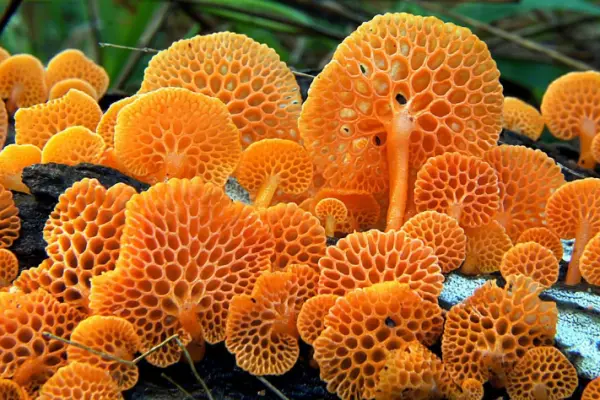
Another bioluminescent species of the Panellus genus, Panellus pusillus, seems to be bright string lights strung across forest tree branches at night. On the substrate, this extremely small, cream-to-white to orange fungus develops in layers.
The major luminous bodies are cream pores, which are quite huge for the size of the fruit body. Panellus pusillus has a wide distribution and we can find them in many places on the planet.
10. Bleeding Fairy Helmet
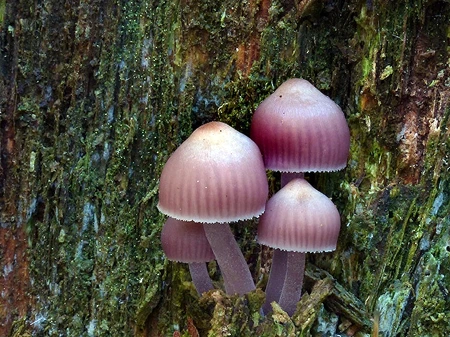
The little crown of the Bleeding Fairy Helmet often has a bell-shaped or convex form. The color of the cap can range from pale brown to reddish brown or even deep burgundy.
The distinguishing characteristic of this mushroom, especially when young or fresh, is the “bleeding” or oozing of droplets of rich burgundy-colored liquid from the edges or the base of the cap.
In comparison to other species in this list, this species exhibits quite weak bioluminescence.
11. Moon Night Mushroom (Omphalotus japonicus)
The next species on this list of Glowing Mushrooms is a poisonous mushroom, Moon Night Mushroom (Omphalotus japonicas) responsible for as much as 31.6% of the poisoning cases.
The primary reason being this species is confused with the more often-eaten Oyster mushrooms, leading to diarrhea, vomiting, and other gastrointestinal diseases.
The glowing bodies are the gills, and the glow emits a whitish light. The Japanese name for this species stands for Moon night mushroom, for this white glow, like a moonlit night.
12. Mycena illuminans
The bioluminescent light of Mycena illuminans is its most alluring characteristic. The whole mushroom exhibits a gentle, greenish luminosity in low light or darkness.
In the tissues of the mushroom, luciferin and luciferase enzymes interact chemically to produce this captivating glow.
Mycena illuminans has a wide geographic range and we can find them in a number of temperate and boreal locations, including North America, Europe, and Asia.
13. Lilac Bonnet Mushroom
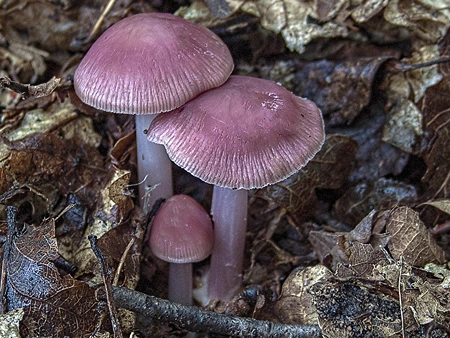
Mycena pura generally has a small to medium-sized crown with a convex shape that gradually flattens with ageing. Although the colour of the cap might vary, it often displays lilac or mild purplish-gray tones, thus the widespread name “Lilac Bonnet.”
There are many places in the world where we can find Mycena pura, including North America, Europe, Asia, and other temperate and boreal areas.
14. Mycenena citricolor
Mycenena citricolor is not any ordinary fungus species, but a terror for coffee plantation owners. These fungi appear as small dots on coffee leaves and become evident especially at night due to their luminescence.
The affected leaves start developing holes, and eventually with more and more fungal infestation, the plant eventually dies.
15. Yellowleg Bonnet
Finally, the last species on this list of Glowing Mushrooms is the Yellowleg Bonnet (Mycena epipterygia). It emerges gregariously from the well-decomposed deadwood of conifers and has a sticky cap with greenish-yellow coloration.
We can easily distinguishes these size mushrooms, from other similar-looking species, thanks to their transparent nature and long, lemon yellow to greenish stems. Although these mushrooms are edible, they are so insignificant that it would be a waste to gather them for food.
Now we have come to the end of this article on Glowing Mushrooms. We have a host of other articles on this very website, dealing with a wide spectrum of niches like reptiles, insects, mammals, birds, and ways to take care of the nature around you.
Make sure to check out those. We will be back with another interesting article, so until then, stay tuned.
References:
- First Nature- Mycena epipterygia
- Mushroom appreciation- Jack O’ Lantern Mushrooms
- fungimap.org- Little Ping Pong Bat
- researchgate- Formation of Fruiting Body of Omphalotus japonicus by Sawdust Cultivation
Also Read:

A zoology student turned writer. Nature has always been a magnet to me, and to unearth some of its secrets through my articles is my prime intention. If not engaging myself with nature and anime content, you can always find me going through some Bengali classics or filling the air with some soulful Tabla beats. An artist, trying to throw some colors to my blank canvas of life.
